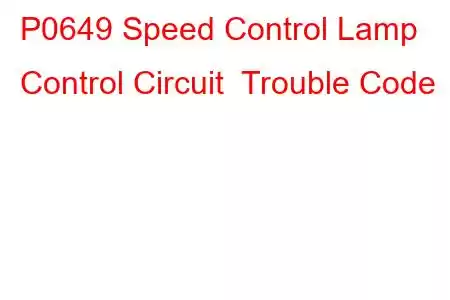P0649 Speed Control Lamp Control Circuit
OBD-II Trouble Code Technical Description
Speed Control Lamp Control Circuit
What does that mean?
This is a generic diagnostic trouble code (DTC) and applies to many OBD-II vehicles (1996-newer). That may include but is not limited to vehicles from Ford, Chevrolet, Chrysler, Dodge, Ford, Jeep, Hyundai, Honda, etc. Although generic, the exact repair steps may vary depending on year, make, model and powertrain configuration.
A stored code P0649 means that the powertrain control module (PCM) has detected a malfunction in the speed control lamp control circuit.
The speed control lamp is contained in the instrument panel. Its primary function is to alert the driver that the speed control system has been activated (when it is illuminated). The speed control system is also called the cruise control.
The PCM typically monitors the continuity of the speed control lamp control circuit whenever the ignition is turned on. The speed control system uses input signals from the vehicle speed sensor (VSS) and/or wheel speed sensors to regulate vehicle speed automatically (after the system is activated by the driver).
Each time the ignition is turned on and the PCM is energized, multiple controller self-tests are performed. In addition to running internal controller self-tests, the controller area network (CAN) carries serial data from each individual module to ensure that on-board controllers are interfacing properly.
If a problem is detected in monitoring the speed control lamp control circuit, a code P0649 will be stored and a malfunction indicator lamp (MIL) may be illuminated.
One style of cruise control lamp indicator:
What is the severity of this DTC?
All internal control module codes should be taken seriously. A stored code P0649 (with speed control lamp illumination) will likely result in a loss of speed control activation.
What are some of the symptoms of the code?
Symptoms of a P0649 trouble code may include:
Speed control system inoperative Other stored (speed control) codesWhat are some of the common causes of the code?
Causes for this code may include:
Faulty PCM PCM programming error Open or shorted speed control lamp control circuit Defective speed control lamp bulbWhat are some P0649 troubleshooting steps?
A diagnostic scanner, a digital volt/ohmmeter (DVOM), and a source of reliable vehicle information will be required to diagnose a code P0649.
Consult your vehicle information source for technical service bulletins (TSB) that replicate the code stored, vehicle (year, make, model, and engine), and symptoms exhibited. If you find the appropriate TSB, it may yield helpful diagnostic information.
Begin by connecting the scanner to the vehicle diagnostic port and retrieving all stored codes and freeze frame data. You will want to write this information down, just in case the code proves to be an intermittent one. After recording all pertinent information, clear the codes and test drive the vehicle until the code is reset or the PCM enters readiness mode.
If the PCM enters readiness mode, the code is intermittent and will be more difficult to diagnose. The condition, which caused the P0649 to be stored, may need to worsen before an accurate diagnosis can be reached. If the code is reset, continue with your diagnosis.
Use your source of vehicle information to obtain connector face views, connector pin-out charts, component locators, wiring diagrams, and diagnostic flow charts related to the code and vehicle in question.
Check to see if there is battery voltage on the speed control warning lamp circuit by using the appropriate wiring diagram and your DVOM. If not check system fuses and relays and replace defective parts as required. If voltage is discovered at the speed control warning lamp, su
Read: 37


